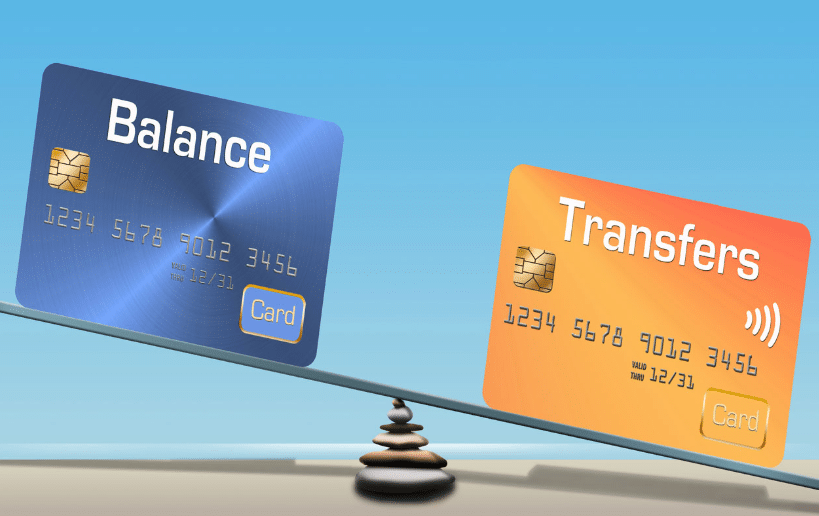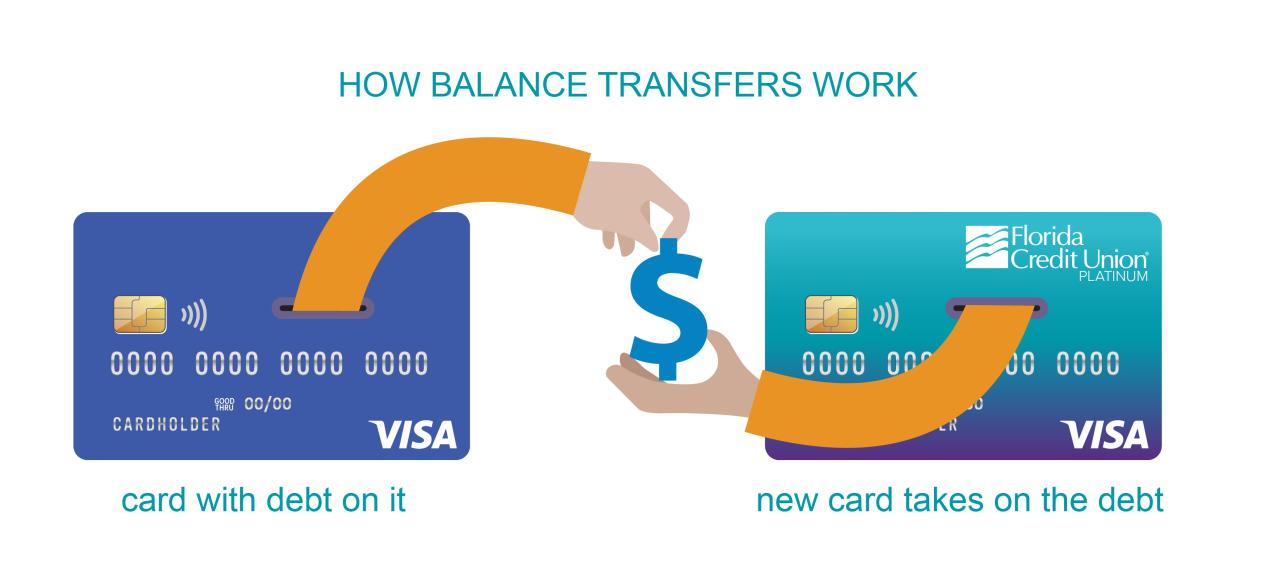
Credit card to transfer balance – Transferring your credit card balance can be a smart move if you’re looking to save money on interest. By transferring your balance to a card with a lower APR, you can potentially reduce the amount of interest you pay over time. However, it’s important to understand the ins and outs of balance transfers before you jump in. This includes understanding the benefits, drawbacks, and potential pitfalls associated with this strategy.
In this guide, we’ll delve into the world of balance transfers, covering everything from choosing the right card to managing your transferred balance effectively. We’ll also explore alternative methods for managing high-interest debt, so you can make the best decision for your financial situation.
Understanding Balance Transfers
A balance transfer credit card allows you to move existing debt from one credit card to another, often with a lower interest rate. This can be a valuable tool for saving money on interest charges and paying off your debt faster.
Benefits of Balance Transfers
Balance transfers can offer several advantages, making them a potentially attractive option for managing your debt.
- Lower Interest Rates: The primary benefit of balance transfers is the opportunity to secure a lower interest rate on your existing debt. This can significantly reduce your monthly payments and help you pay off your balance faster.
- Consolidation of Debt: Balance transfers allow you to consolidate multiple credit card balances into a single account, simplifying your debt management and potentially reducing the number of monthly payments you need to track.
- Promotional Periods: Many balance transfer credit cards offer introductory periods with 0% interest rates, providing a valuable opportunity to make significant progress on your debt without accruing additional interest charges. However, it’s crucial to note that these promotional periods are typically temporary, and after they expire, the standard interest rate applies.
Drawbacks of Balance Transfers
While balance transfers can offer significant benefits, it’s essential to be aware of potential drawbacks.
- Balance Transfer Fees: Most balance transfer credit cards charge a fee for transferring your balance. This fee can range from 3% to 5% of the transferred amount. Therefore, it’s essential to compare balance transfer fees across different cards and factor them into your calculations.
- Limited Time Offers: Introductory 0% interest rates on balance transfers are typically limited to a specific period, usually 12 to 18 months. After this period, the standard interest rate applies, which can be significantly higher than the introductory rate. To avoid this, ensure you have a plan to pay off your balance before the promotional period expires.
- Credit Score Impact: Applying for a new credit card can temporarily lower your credit score, as it represents a hard inquiry on your credit report. It’s important to consider the potential impact on your credit score before applying for a balance transfer card.
Finding the Right Balance Transfer Card: Credit Card To Transfer Balance

Choosing the right balance transfer card can save you significant money on interest charges. However, with so many options available, it’s important to carefully evaluate your needs and compare different offers before making a decision.
Factors to Consider When Choosing a Balance Transfer Card
When selecting a balance transfer card, consider the following factors:
- Introductory APR: This is the interest rate you’ll pay for a specified period, usually 12-18 months. Look for cards with the lowest introductory APR to minimize interest charges.
- Balance Transfer Fee: Most cards charge a fee, typically a percentage of the amount transferred, for moving your balance. Compare fees across different cards to find the most affordable option.
- Transfer Limit: The maximum amount you can transfer to the new card. Ensure the limit is sufficient to cover your existing balance.
- Regular APR: This is the interest rate you’ll pay after the introductory period ends. Choose a card with a reasonable regular APR to avoid high interest charges in the long run.
- Rewards: Some balance transfer cards offer bonus rewards, such as cash back, points, or miles. Consider whether these benefits align with your spending habits and priorities.
- Other Fees: Check for any additional fees, such as annual fees, late payment fees, or over-limit fees. Avoid cards with excessive fees.
Comparing Balance Transfer Offers
Once you’ve identified your needs, compare different balance transfer offers from various lenders. Pay close attention to the introductory APR, balance transfer fee, and other key features. Consider the following:
- Promotional Periods: Compare the length of the introductory APR period. Cards with longer promotional periods provide more time to pay down your balance before the regular APR kicks in.
- Transfer Fees: Look for cards with lower transfer fees, as these can significantly impact your overall savings.
- APR After the Promotional Period: Compare the regular APRs of different cards to ensure you’re not stuck with a high interest rate after the promotional period ends.
- Creditworthiness: Your credit score will influence the APR and fees you qualify for. Cards with lower APRs and fees may require a higher credit score.
Key Features of Popular Balance Transfer Cards
Here’s a table showcasing key features of popular balance transfer cards:
| Card Name | Intro APR | Transfer Fee | Bonus Rewards |
|---|---|---|---|
| Card A | 0% for 18 months | 3% of the balance transferred | 2% cash back on all purchases |
| Card B | 0% for 15 months | 2% of the balance transferred | 1 point per dollar spent, redeemable for travel |
| Card C | 0% for 12 months | 1% of the balance transferred | No bonus rewards |
Note: This is just a sample table. Specific offers and features may vary depending on the lender and your individual creditworthiness.
The Transfer Process

Transferring your credit card balance to a new card is a relatively straightforward process, but it’s essential to understand the steps involved and ensure a timely transfer to avoid incurring additional interest charges.
Steps Involved in Transferring a Balance
The transfer process typically involves these steps:
- Apply for a balance transfer card: Choose a card offering a 0% introductory APR for balance transfers and meets your credit requirements. Compare offers from different lenders to find the best terms and conditions.
- Complete the application process: Provide the necessary information and documentation, including your Social Security number, income details, and existing credit card information. The lender will perform a credit check to assess your creditworthiness.
- Receive approval and determine the transfer amount: Once approved, you’ll receive a credit limit for the new card. Determine the amount you want to transfer from your existing card to the new one. Keep in mind that the transfer amount can’t exceed your available credit limit on the new card.
- Initiate the transfer: Contact the new card issuer and provide them with the details of the credit card you want to transfer the balance from, including the account number and the amount to be transferred. You can typically initiate the transfer online, over the phone, or through the mobile app.
- Receive confirmation and track the transfer: The new card issuer will confirm the transfer request and provide you with a tracking number to monitor the progress. The transfer process can take a few business days to complete.
Importance of Timely Transfer Completion
It’s crucial to ensure that the balance transfer is completed before the introductory 0% APR period expires on your new card. If the transfer is not completed within the specified timeframe, you may be subject to the regular APR on your new card, potentially increasing your interest charges and negating the benefits of the balance transfer.
Documents Required for Balance Transfer
To facilitate a smooth balance transfer, you may need to provide the following documents:
- Proof of identity: A government-issued ID, such as a driver’s license or passport, is usually required for verification.
- Social Security number: This is essential for credit checks and account setup.
- Income verification: You may need to provide pay stubs or tax returns to demonstrate your income and creditworthiness.
- Existing credit card details: This includes your account number, the amount you want to transfer, and the name of the issuer of the existing card.
Managing Your Balance Transfer
A balance transfer can be a helpful tool for saving money on interest charges, but it’s essential to manage it effectively to maximize its benefits. This involves taking proactive steps to ensure you pay down the transferred balance as quickly as possible and avoid accruing new debt.
Strategies for Paying Down the Transferred Balance
Paying down the transferred balance as quickly as possible is crucial to avoid accruing interest charges and maximizing the benefits of the balance transfer. Here are some strategies:
- Make more than the minimum payment. The minimum payment on a credit card is often a small percentage of the balance, meaning it can take years to pay off the debt. By making larger payments, you can significantly reduce the amount of interest you pay and shorten the repayment period.
- Set a budget and stick to it. Create a budget that allocates extra funds to your balance transfer payment. This will help you stay on track and ensure you’re making consistent progress toward paying off the debt.
- Consider a debt consolidation loan. If you have multiple high-interest debts, a debt consolidation loan can help you consolidate them into a single loan with a lower interest rate. This can simplify your payments and potentially save you money on interest.
- Use the snowball or avalanche method. The snowball method involves paying off your smallest debt first, while the avalanche method focuses on paying off the debt with the highest interest rate first. Both methods can help you stay motivated and make progress toward paying off your debt.
Maintaining Good Credit Utilization
Credit utilization is the percentage of your available credit that you’re using. Maintaining good credit utilization after a balance transfer is essential for maintaining a healthy credit score.
Credit utilization is calculated by dividing your total credit card balances by your total credit limits. For example, if you have a total credit limit of $10,000 and a total balance of $2,000, your credit utilization is 20%.
- Keep your credit utilization below 30%. A credit utilization ratio below 30% is generally considered good, as it shows lenders that you’re managing your credit responsibly.
- Pay down balances promptly. Making timely payments can help keep your credit utilization low and improve your credit score.
- Avoid opening new credit accounts. Opening new credit accounts can lower your average credit age and increase your credit utilization, which can negatively impact your credit score.
Avoiding Common Pitfalls

Balance transfers can be a great way to save money on interest, but they’re not without their risks. If you’re not careful, you could end up paying more in fees than you save in interest. Here are some common pitfalls to avoid when using a balance transfer card:
Understanding Balance Transfer Fees, Credit card to transfer balance
Balance transfer fees are a common charge associated with transferring debt from one card to another. These fees can vary significantly depending on the card issuer and the amount of debt being transferred. It’s crucial to understand these fees before initiating a balance transfer, as they can eat into the potential savings you’re hoping to achieve.
Late Payment Penalties
Missing a payment on a balance transfer card can result in significant penalties, including late fees and increased interest rates. These penalties can quickly negate any savings you’ve achieved through the balance transfer.
Exceeding Credit Limits
Exceeding your credit limit on a balance transfer card can lead to over-limit fees and potentially damage your credit score. It’s important to monitor your spending and ensure you stay within your credit limit to avoid these penalties.
Interest Accrual
While balance transfer cards offer a promotional period with 0% interest, this period is usually temporary. Once the promotional period ends, interest will start accruing on the transferred balance at the card’s standard APR. This can negate the savings you initially achieved, so it’s crucial to pay down the balance before the promotional period ends.
Alternatives to Balance Transfers
While balance transfers can be a valuable tool for managing high-interest debt, they are not the only solution. Other methods can help you reduce your debt and save money.
Exploring alternative options can be beneficial if a balance transfer doesn’t suit your needs or you’re looking for a more comprehensive approach to debt management.
Debt Consolidation Loans
Debt consolidation loans allow you to combine multiple debts into a single loan with a lower interest rate. This can simplify your payments and potentially reduce your overall interest costs.
Here’s how debt consolidation works:
- Apply for a loan: You apply for a consolidation loan from a lender, such as a bank or credit union. The loan amount should cover all your existing debts.
- Receive loan funds: Once approved, you receive the loan funds and use them to pay off your existing debts.
- Make a single monthly payment: You make a single monthly payment to the consolidation loan lender, which covers all your combined debts.
Pros and Cons of Debt Consolidation Loans
- Pros:
- Lower monthly payments
- Reduced interest costs
- Simplified debt management
- Cons:
- May not always lower interest rates
- Can extend the repayment term, leading to higher overall interest costs
- May require a credit score to qualify
Balance Transfers vs. Debt Consolidation Loans
Balance transfers and debt consolidation loans offer different advantages and disadvantages.
Balance Transfers
- Pros:
- Lower interest rates for a limited period
- Can be a good option for short-term debt management
- Cons:
- Interest rates revert to a higher rate after the introductory period
- May involve balance transfer fees
- Not suitable for long-term debt management
Debt Consolidation Loans
- Pros:
- Lower interest rates for the entire loan term
- Can be a good option for long-term debt management
- Cons:
- May have higher upfront costs, such as origination fees
- May require a credit score to qualify
Resources for Individuals Struggling with Debt
Several resources can provide support and guidance to individuals struggling with debt.
- Credit counseling agencies: These agencies offer free or low-cost financial counseling services, including debt management plans.
- Non-profit organizations: Organizations like the National Foundation for Credit Counseling (NFCC) provide educational resources and debt management programs.
- Government programs: Some government programs, such as the Consumer Financial Protection Bureau (CFPB), offer information and assistance to consumers facing financial difficulties.
Final Conclusion
Ultimately, the decision of whether or not to transfer your credit card balance is a personal one. However, by understanding the key factors involved and weighing the pros and cons, you can make an informed decision that’s right for you. Remember, balance transfers can be a powerful tool for saving money on interest, but they should be used strategically and with careful planning.
Answers to Common Questions
How long does it take to transfer a balance?
The transfer process can take anywhere from a few days to a few weeks, depending on the lender and the specific transfer request.
What happens if I miss a payment on my balance transfer?
Missing a payment on a balance transfer can result in the introductory APR reverting to the standard APR, which is typically much higher. You may also be subject to late fees and penalties.
Can I transfer my balance multiple times?
While you may be able to transfer your balance multiple times, be aware that each transfer may come with a fee. Additionally, lenders may have restrictions on how often you can transfer balances.





